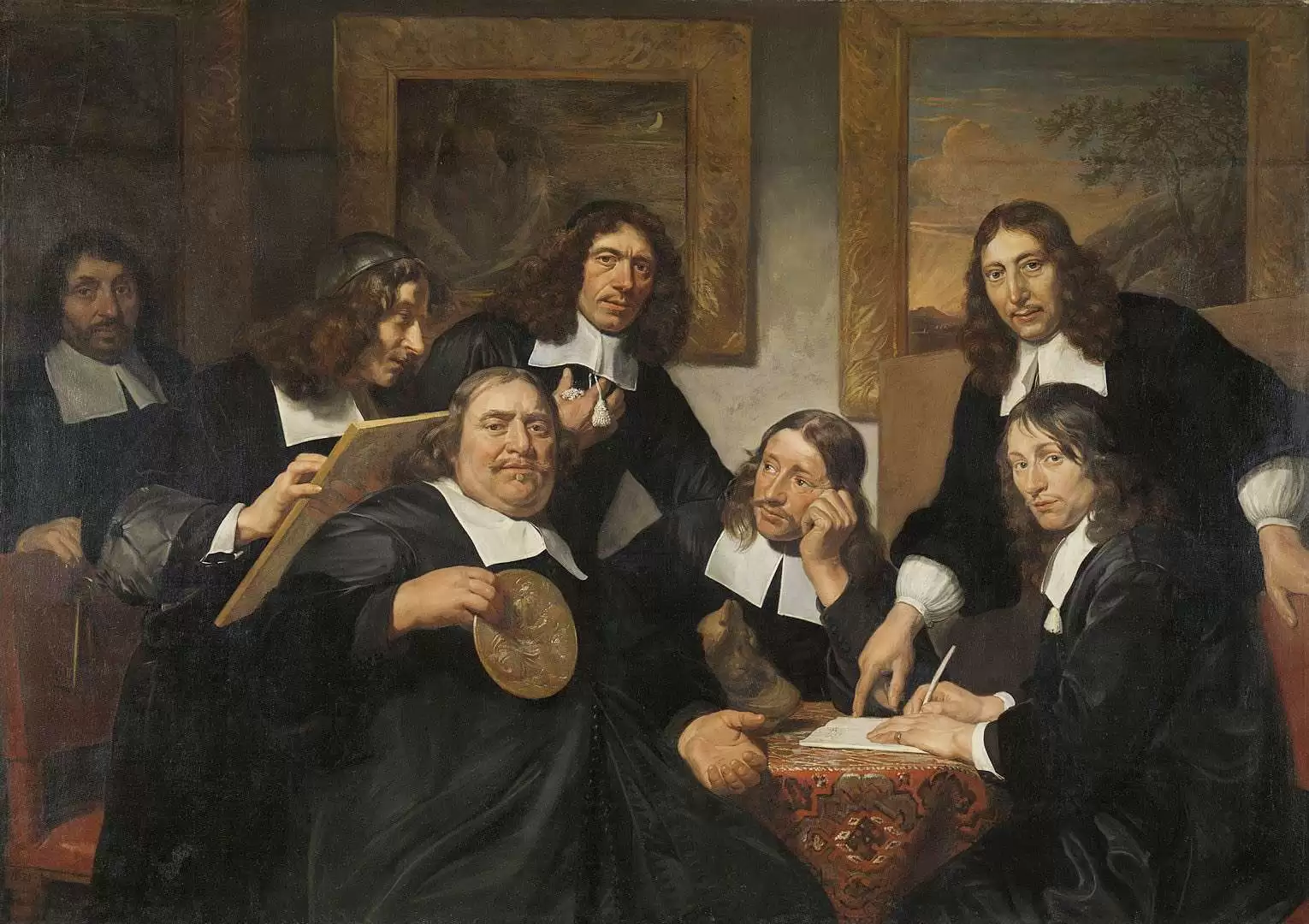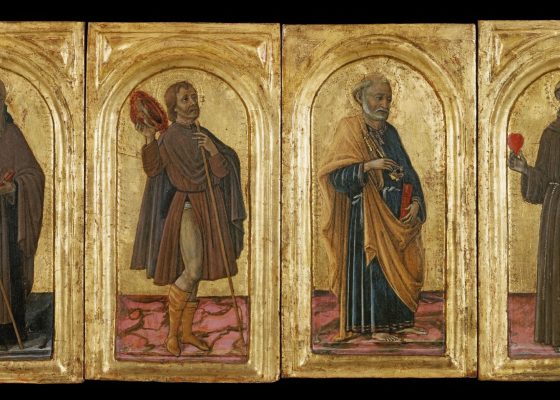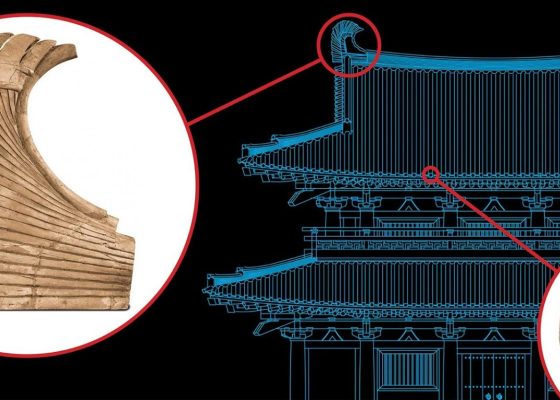
By Wei J C
The Dutch in the Seventeenth Century—A Commercial Republic
Lairesse’s idealism and Rembrandt’s realism are two ends of the spectrum in art. They existed and were evenly matched at the same time, and had left different influences on later generations. While European countries were engaged in endless religious wars in the 17th century, the Netherlands had gained independent from Spain, established a republic, and actively engaged in maritime trade and slowly accumulated
wealth.
In 1602, the Dutch East India Company was established. It was the first multinational company ever to be financed by stocks, and later help to establish the first modern stock exchange. The company led the Netherlands to gain monopoly in trade with Asia for two centuries, making it the largest trading country in world in the 17th century. In 1609, the Bank of Amsterdam was established as the first central bank.
The social status of the Dutch at that time was largely depended on personal income. The importance of the nobility was gradually diminishing, and urban merchants were becoming the dominant Dutch social class. Large-scale paintings and sculptures funded by the Holy See and the lords were seen no more; the nobles even became attached to successful businessmen. The painters have lost their major clients, and historical paintings were less in demand. All this gave rise to the many realist painters such as Frans Hals, Jan Steen, Pieter de Hooch, and Rembrandt.

The Dutch practiced Calvinist Protestantism and had prohibited religious paintings in churches. This was one of the important reasons that Dutch paintings become secularized. Although biblical-themed paintings were still in demand in private homes, the production volume and layout were relatively small. Only artists like Lairesse and Johanna Vermeer (1632-1675), who lived in Delft, held on to the sublime traditional of classical painting. Vermeer had created few works in his life due to his rigorous attitude towards painting.
In the Dutch golden age, when most focused on the themes of everyday life, he was a unique and inscrutable painter. His Girl with a Pearl Earring, in particular, was regarded as the Netherlands’ national treasure; people would even compare it with the Mona Lisa. The lives of the women portrayed in the two paintings were both mysteries to later generations: one seems to be a mysterious upper-class lady, and the other is like a pearl among the folks.
Johanne Vermeer, the Pinnacle of “Bourgeois” (Johannes Vermeer, 1632-1675)
The social trends of the commercial powers have allowed businessmen to gradually establish the middle class in the Netherlands. Women’s lives and liberty have also changed. Young women were allowed to learn, to be entertained, to socialize, and to read. Under in this environment, the people’s moral consciousness have also begun to change. Paintings of “women’s daily life” and of secular world appeared in large quantity. Buyers can be lawyers, physicians, businessmen, industrialists, and officials of major national institutions. Portrait paintings were no longer the privileges of nobles, and paintings of women’s daily activities are also created one by one.
The most representative and independent artists should be Johannes Vermeer (1632-1675). His works cover all aspects of the Dutch society in the 17th century, from milkmaids to the affluent celebrities and wealthy businessmen in their spacious homes.
Unlike Rembrandt, who has self-portraits from youth to old age, Vermeer was a man of mystery, and little is known about him. Vermeer’s paintings reflect the world he lived in. The paintings he left behind include themes of religious allegories, poems, women, music, and scientific criticism. But there are no portrait or log about himself. He lived a short forty-three years, fathered ten children, and worked as a painter and an art dealer. According to scholars’ textual research, he did about forty-five to sixty paintings throughout his life, and only 36 still exists. The Metropolitan holds a total of five paintings, all of which appeared in this exhibition.

Vermeer’s paintings are said to be the exquisite taste of the “Bourgeois.” There is a sense of transcendent tranquility in his paintings, whether it be a lady getting dressed, a young woman reading a letter, or a maid at work, they all have a sense of privacy, as if they are completely undisturbed by the outside world. It is hard to imagine that he can create such quiet paintings with his ten children around.
This tranquility is not only the expansion from the internal to the external environment. Vermeer’s landscape paintings, such as the View of Delft, make it for us to believe that this was the golden age of a prosperous society. Scholars found that this large-scale landscape painting may not be a contracted work. He didn’t have many buyers, even as a broker himself, who knew the type of paintings that would sell. It seemed that he has drawn a clear boundary on this matter. There was no hesitation in his use of expensive coloring materials: lapis lazuli and yellow ochre were repeatedly used in his paintings.
In Young Woman with a Water Jug, (ca. 1660-1662), a woman stands by an open window, holding a gold jug and placing it on the gilded basin; she was covered with white linen from head to body. It reflects the artist’s interest in family themes, and observation of women’s private lives. In The Milkmaid (ca. 1657-1658), the plump and strong maid shows the abundance of the society, the richness in material supplies; the maid’s hands are strong, and her movements are skillful and steady.

In this period, sacred religious paintings were no longer demanded in every household, and the number of religious paintings were scarce and with a different categorization. When the Dutch Republic prohibited public Mass celebrations, Vermeer depicted the victory of the Catholic Church in the Allegory of the Catholic Faith (ca, 1670-1672) using a complicated parable. Religion has always been the main theme throughout European history. This painting, however, was the only work in the genre of religious history created during that period of time. The content of his paintings reflects his dedication to the study of religion, astronomy, navigation, and people; they were a microcosm of the Dutch social phenomenon at the time.
The difference between the lighting in his paintings and that of Rembrandt’s is that one was intuitive, while the other was created under an objective environment. With the decline of the Dutch Republic, Vermeer was troubled with financial problems. According to later textual research, he died of illness caused by financial pressure. Vermeer’s works was discovered two centuries after his death, much like Rembrandt, whose paintings was rediscovered in the 18th century. But Rembrandt lived much longer than Vermeer and created more paintings; he was also an art dealer and had many collectors at the time. In comparison, Vermeer was unknown to the public during his lifetime, and he never travelled beyond Delft.
Either the renowned Rembrandt or the nameless Vermeer, they struggled in art creation, often relying on family business or the appreciation of a small number of collectors; yet their artistic life ended with the decline of the Dutch Republic. It was not until a hundred years later that Rembrandt was seen again; while Vermeer’s exquisite paintings have become the national treasure of the Netherlands. As for Lairesse’s delicate, enlightening, and aristocratic art was completely obscured by the bourgeois painters.
We are grateful to Rembrandt for leaving us with a portrait of Lairesse, even if it is dim and dark, and covered in muck.
A Safe Haven for Scholars and Advisers
A phenomenon was observed in the Dutch Republic at that time: the scholars, literati, and scientists who the authorities had regarded as heretics all fled to the Netherlands, such as the French mathematician René Descartes (1596-1650); the British political philosopher Thomas Hobbes, who lived in the Netherlands for twenty years (1629-1649) , had to print Leviathan, in which he advocated “Social Contract,” in Amsterdam. John Locke, once known as the greatest European philosopher of the 17th century, also took refuge in the Netherlands. The Jewish philosopher Benedict de Spinoza, who is difficult to classify, stayed in Amsterdam until his death. Other renowned scientists, biologists, and writers also lived in the Netherlands at the time.
The Netherlands is relatively tolerant compared to other European countries. In particular, the strict censorship in other countries provided conditions for the Netherlands to become the largest country in the book trade. Additionally, the Dutch have a high literacy rate, and entrepreneurs benefited from it. As a result, the Netherlands in the 17th century became an important center for the production of banned books, news, Bibles, and political pamphlets, until the end of the 17th century and the beginning of the 18th century when the Dutch Republic collapsed and Great Britain rose.
Conclusion
Lairesse’s work has been exhibited in many museums around the world in recent years, including the Rijksmuseum in Amsterdam and the Amsterdam Museum, the Louvre in Paris, the National Gallery in Washington, D.C., the National Portrait Gallery and Tate Gallery in London, and the Cleveland Museum of Art. The National Museum of Twente in Enschede also held an exhibition and conference on Lairesse’s works from 2016 to 2017. And what does the Apollo and Aurora exhibiting in the Metropolitan Museum at this moment symbolize? The rebirth of the elite aristocratic art? The weariness of the all-encompassing modern art? Is it possible for art to return to the path of idealism, to the admiration of the gods, and to classicism? If we believe that art is a bridge given to men to communicate with God, then art is not just a means to vent human emotions. Moderation and cultivation will always be necessary.◇













Cancel anytime


Using our website
You may use the The Middle Land website subject to the Terms and Conditions set out on this page. Visit this page regularly to check the latest Terms and Conditions. Access and use of this site constitutes your acceptance of the Terms and Conditions in-force at the time of use.
Intellectual property
Names, images and logos displayed on this site that identify The Middle Land are the intellectual property of New San Cai Inc. Copying any of this material is not permitted without prior written approval from the owner of the relevant intellectual property rights.
Requests for such approval should be directed to the competition committee.
Please provide details of your intended use of the relevant material and include your contact details including name, address, telephone number, fax number and email.
Linking policy
You do not have to ask permission to link directly to pages hosted on this website. However, we do not permit our pages to be loaded directly into frames on your website. Our pages must load into the user’s entire window.
The Middle Land is not responsible for the contents or reliability of any site to which it is hyperlinked and does not necessarily endorse the views expressed within them. Linking to or from this site should not be taken as endorsement of any kind. We cannot guarantee that these links will work all the time and have no control over the availability of the linked pages.
Submissions
All information, data, text, graphics or any other materials whatsoever uploaded or transmitted by you is your sole responsibility. This means that you are entirely responsible for all content you upload, post, email or otherwise transmit to the The Middle Land website.
Virus protection
We make every effort to check and test material at all stages of production. It is always recommended to run an anti-virus program on all material downloaded from the Internet. We cannot accept any responsibility for any loss, disruption or damage to your data or computer system, which may occur while using material derived from this website.
Disclaimer
The website is provided ‘as is’, without any representation or endorsement made, and without warranty of any kind whether express or implied.
Your use of any information or materials on this website is entirely at your own risk, for which we shall not be liable. It is your responsibility to ensure any products, services or information available through this website meet your specific requirements.
We do not warrant the operation of this site will be uninterrupted or error free, that defects will be corrected, or that this site or the server that makes it available are free of viruses or represent the full functionality, accuracy and reliability of the materials. In no event will we be liable for any loss or damage including, without limitation, loss of profits, indirect or consequential loss or damage, or any loss or damages whatsoever arising from the use, or loss of data, arising out of – or in connection with – the use of this website.
Last Updated: September 11, 2024
New San Cai Inc. (hereinafter “The Middle Land,” “we,” “us,” or “our”) owns and operates www.themiddleland.com, its affiliated websites and applications (our “Sites”), and provides related products, services, newsletters, and other offerings (together with the Sites, our “Services”) to art lovers and visitors around the world.
This Privacy Policy (the “Policy”) is intended to provide you with information on how we collect, use, and share your personal data. We process personal data from visitors of our Sites, users of our Services, readers or bloggers (collectively, “you” or “your”). Personal data is any information about you. This Policy also describes your choices regarding use, access, and correction of your personal information.
If after reading this Policy you have additional questions or would like further information, please email at middleland@protonmail.com.
PERSONAL DATA WE COLLECT AND HOW WE USE IT
We collect and process personal data only for lawful reasons, such as our legitimate business interests, your consent, or to fulfill our legal or contractual obligations.
Information You Provide to Us
Most of the information Join Talents collects is provided by you voluntarily while using our Services. We do not request highly sensitive data, such as health or medical information, racial or ethnic origin, political opinions, religious or philosophical beliefs, trade union membership, etc. and we ask that you refrain from sending us any such information.
Here are the types of personal data that you voluntarily provide to us:
As a registered users or customers, you may ask us to review or retrieve emails sent to your business. We will access these emails to provide these services for you.
We use the personal data you provide to us for the following business purposes:
Information Obtained from Third-Party Sources
We collect and publish biographical and other information about users, which we use to promote the articles and our bloggers who use our sites. If you provide personal information about others, or if others give us your information, we will only use that information for the specific reason for which it was provided.
Information We Collect by Automated Means
Log Files
The site uses your IP address to help diagnose server problems, and to administer our website. We use your IP addresses to analyze trends and gather broad demographic information for aggregate use.
Every time you access our Site, some data is temporarily stored and processed in a log file, such as your IP addresses, the browser types, the operating systems, the recalled page, or the date and time of the recall. This data is only evaluated for statistical purposes, such as to help us diagnose problems with our servers, to administer our sites, or to improve our Services.
Do Not Track
Your browser or device may include “Do Not Track” functionality. Our information collection and disclosure practices, and the choices that we provide to customers, will continue to operate as described in this Privacy Policy, whether or not a “Do Not Track” signal is received.
HOW WE SHARE YOUR INFORMATION
We may share your personal data with third parties only in the ways that are described in this Privacy Policy. We do not sell, rent, or lease your personal data to third parties, and We does not transfer your personal data to third parties for their direct marketing purposes.
We may share your personal data with third parties as follows:
There may be other instances where we share your personal data with third parties based on your consent.
HOW WE STORE AND SECURE YOUR INFORMATION
We retain your information for as long as your account is active or as needed to provide you Services. If you wish to cancel your account, please contact us middleland@protonmail.com. We will retain and use your personal data as necessary to comply with legal obligations, resolve disputes, and enforce our agreements.
All you and our data are stored in the server in the United States, we do not sales or transfer your personal data to the third party. All information you provide is stored on a secure server, and we generally accepted industry standards to protect the personal data we process both during transmission and once received.
YOUR RIGHTS/OPT OUT
You may correct, update, amend, delete/remove, or deactivate your account and personal data by making the change on your Blog on www.themiddleland.com or by emailing middleland@protonmail.com. We will respond to your request within a reasonable timeframe.
You may choose to stop receiving Join Talents newsletters or marketing emails at any time by following the unsubscribe instructions included in those communications, or you can email us at middleland@protonmail.com
LINKS TO OTHER WEBSITES
The Middle Land include links to other websites whose privacy practices may differ from that of ours. If you submit personal data to any of those sites, your information is governed by their privacy statements. We encourage you to carefully read the Privacy Policy of any website you visit.
NOTE TO PARENTS OR GUARDIANS
Our Services are not intended for use by children, and we do not knowingly or intentionally solicit data from or market to children under the age of 18. We reserve the right to delete the child’s information and the child’s registration on the Sites.
PRIVACY POLICY CHANGES
We may update this Privacy Policy to reflect changes to our personal data processing practices. If any material changes are made, we will notify you on the Sites prior to the change becoming effective. You are encouraged to periodically review this Policy.
HOW TO CONTACT US
If you have any questions about our Privacy Policy, please email middleland@protonmail.com
The Michelin brothers created the guide, which included information like maps, car mechanics listings, hotels and petrol stations across France to spur demand.
The guide began to award stars to fine dining restaurants in 1926.
At first, they offered just one star, the concept was expanded in 1931 to include one, two and three stars. One star establishments represent a “very good restaurant in its category”. Two honour “excellent cooking, worth a detour” and three reward “exceptional cuisine, worth a
Thank you for your participation,
please Log in or Sign up to Vote

123Sign in to your account